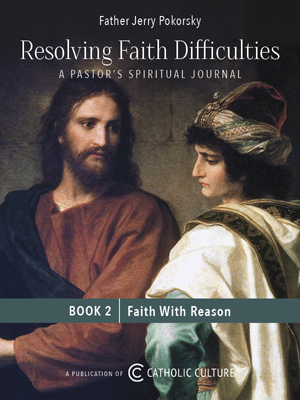Ignatius and T. M. Doran: Toward the Gleam
By Dr. Jeff Mirus ( bio - articles - email ) | Jul 22, 2011 | In Reviews
If you follow Catholic fiction at all, you’ll be wondering about the recent novel published by Ignatius Press, T. M. Doran’s Toward the Gleam. The title is intriguing, even if you will never know why it was chosen. And though I personally found the book enjoyable, you may still be wondering about it when you’ve finished this review.
The premise of Toward the Gleam is that J. R. R. Tolkien’s Lord of the Rings arose from a translation of an ancient manuscript—as old as the lost civilization of Atlantis—which Tolkien found, learned to read, and accepted as true history, but thought the world unprepared to receive as fact. The manuscript was found by the main character, referred to as John, in a box made of a metal alloy unknown to contemporary science, a box that could be opened by pressing on it just so, without any visible mechanical process.
The tension and mystery of the tale is created by this almost magical box and the mesmerizing, seemingly authentic epic it contains—and by the fact that certain sinister persons, led by one Alembert, watch John’s every move in an effort to figure out exactly what he has found so that they can gain it for themselves. The chief question the reader will have to answer for himself in reading Toward the Gleam is whether any of this is remotely believable (always a difficulty when situating fantasy in the real world) or, perhaps more important, whether even if it is believable we ought to care much about this mysterious manuscript, of which we are told almost nothing. We are told so little, in fact, that unless you’ve read Tolkien, you won’t recognize the lure of the One Ring running unnamed through the tale.
Over the decades beginning at the end of World War I, during which John patiently works on deciphering the language, translating the manuscript, and ultimately publishing much of it as a story, we also meet a number of his friends, from whom he seeks advice. Everyone is referred to by first names, which makes it more difficult to determine exactly whom they are supposed to represent. But if you know a bit of the English literary landscape of the first half of the twentieth century, and something of Tolkien’s own relationships, you’ll recognize people such as Jack, Owen, Gilbert and Agatha. But a second question the reader must ask is whether there is really much of a future in continuing to write fiction with an obvious dependency on the Inklings, as two recent Ignatius Press offerings have now done.
Having raised these two questions, however, I’ve raised the two most significant reservations I have about the book. It is, after all, well-written, the characters are interesting and believable, and the growing materialist ideologies of the period provide a nice backdrop for the essentially Catholic outlook of the protagonists. The story unfolds slowly, more like a real novel than a mere mystery, and this is probably consistent with superior literature. At 466 pages, it has a certain heft to it, and while I found it a bit too easy to lay aside during the first two-thirds or so of the narrative, I found the last third more gripping—and, in fact, I was intrigued throughout.
My wife, who has taught English literature to high school seniors for more years than either of us cares to report, read Toward the Gleam just ahead of me, and liked it considerably more. Based on the response in my family, then, I would have to guess that most literary Catholics will find Doran’s novel either passable or good. Fans of The Lord of the Rings might also find that Doran’s conception of the birth of that trilogy adds to the verisimilitude Tolkien had already given to the work through his historical and linguistic background materials, chronologies and maps.
I think you’ll find the story intriguing, as I’ve said, and even haunting. But will you find that it really moves you “toward the gleam”? That’s a question I’ve answered negatively for myself. But if you come away with a stronger sense of the triumph of the human spirit over dead ideologies, a courageous triumph which John Hill, his wife, his children and his friends clearly represent, then you just might answer affirmatively. In the end, my recommendation is to give the book a try, and see whether it becomes an encounter with ultimate meaning for you. Or, as Doran puts it on pages 303 and 304:
“Let us pretend your fictional story about Hope’s fate is true,” Alembert said. “Would it be wise to contend with the person who prescribed Hope’s demise?”
“It would be perilous, I imagine,” Gilbert said.
“Wouldn’t such a person be suicidal, or a fool?”
“You do not account for those of us who value some things more than life,” Gilbert said.
“I have read about them—literary inventions—but I have never met one.”
“A shame. I have met more than a few. Their example has the effect of improving one more often than not.”
All comments are moderated. To lighten our editing burden, only current donors are allowed to Sound Off. If you are a current donor, log in to see the comment form; otherwise please support our work, and Sound Off!








